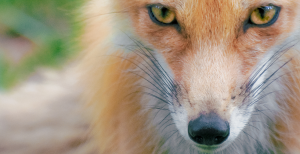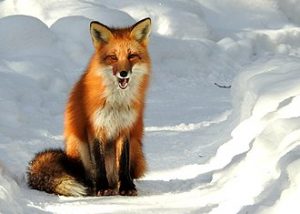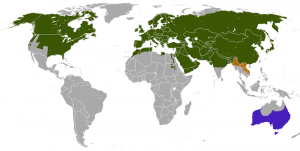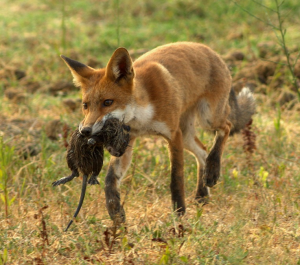19
Dyllan Cole, Billy Cross, Eric Heiman, and Marissa Lima
Chapter Summary
The red fox (Vulpes vulpes) is one of those creatures so common that people rarely give any thought to it. However, the red fox plays an important and unique role in ecosystems across the world. In contrast to the other species in this book, the red fox has a very healthy population size and is actually driving the extinction of other species. Red foxes are highly effective predators and excel in a wide range of ecosystems. To understand extinction, one must look at both sides of the problem, and the red fox is a perfect example of the flip side of extinction.

Physical Characteristics
The red fox is a slender canid, and is known for its red or yellowish-red coat. The species is also known to have characteristic white fur on its underside, black boots, and a white-tipped tail. Two rare color morphs, cross, and silver, also exist. The cross has yellowish to grayish-brown fur and a black cross on its back. The silver fox is known to have a silver to black body. In general, adult red foxes are known to be between 38.4 and 41.3 in. in length and 9 to 13 lbs. in weight (Huebner 2004). There is also a small degree of sexual dimorphism within the species in which the males are slightly larger than the females, specifically in their cranial shape and size (Hartová-Nentvichová et al. 2010).

Figure 1. Red Fox in wild habitat. Take notice of the yellowish-red fur, white ventral fur, and black boots. “Eastern American Red Fox (Vulpes vulpes ssp. fulvus) observed in Algonquin Provincial Park, Ontario on January 2017.” by , CC0 1.0.
Population & Habitat
The exact number of red foxes is unknown because of their broad distribution around the world. Red foxes are extremely abundant, with populations ranging across all of Europe and large portions of Asia. North American populations stretching across most of the eastern contiguous United States and all of Canada and Alaska, as well as populations in Australia and Tasmania (Hoffmann and Sillero-Zubiri 2016). In total, their range covers almost 70 million km2, making them the widest-distributed members of the order carnivora in the world (Hoffmann and Sillero-Zubiri 2016). European populations of red foxes are natural residents of the area (Hoffmann and Sillero-Zubiri 2016), but North American populations are a mix of residents and introduced individuals brought in for fox hunting in the 17th century (Statham et. al. 2012), and Australian and Tasmanian populations are entirely introduced (Hoffmann and Sillero-Zubiri 2016). The few places that this species is not found in are Iceland, the Arctic Islands, parts of Siberia, most of Africa, and Central/South America. This vast population range can be seen in figure 2 below. It is also worth noting that the species has been extirpated in the Republic of Korea due to their population control policies (Canid Specialist Group n.d.). Based on historical data, we can expect the red fox to continue to expand north and east in the future (Allen and Sargeant 1993).

Figure 2. Red fox range, where green = native, purple = introduced, orange = presence uncertain. “Red fox (Vulpes vulpes) range map” by Zoologist, CC BY-SA 3.0
For most of the year, the red fox can be found in conifer woods with their ideal habitat changing throughout the year depending on the weather. Altitude also has an effect on where this species lives. Lower altitudes are popular between the warm and cold seasons, and throughout other months, the higher altitudes are preferred (Cagnacci et al. 2010). The red fox prefers to construct its dens out of sand or gravel substrates and sometimes has been known to utilize and enlarge existing woodchuck or badger dens (Vertebrate Collection – The Department of Biology, n.d.).
Food
From a most basic standpoint, like most mammals, the red fox needs shelter, water, and food. In terms of food, the red fox is mostly nocturnal, its most active periods being dawn and dusk. The red fox is flexible in its diet and is known to consume other mammals, birds, fish, reptiles, invertebrates, and plants. In southern Wisconsin for example, its most popular prey are cottontail rabbits (Vertebrate Collection – The Department of Biology, n.d.). Additionally, red foxes have been expanding into the Arctic due to expanded food resources and greater habitability due to climate change. This is of unique concern due to the red fox’s competition with the Arctic fox (Elmhagen et al. 2018).
Figure 3. Red fox hunting. “Red fox with nutria, Tivoli-Manzolino oasis, Italy.” by Stefano Bettini, CC BY 2.0
Reproduction
The red fox is monogamous for life when it comes to reproducing, and male-female pairs generally form at the start of the winter, in December. Females go into heat shortly after that once per year, in January or February for one through six days. Each litter has between two and ten kits, with a gestation period that averages fifty-three days. After a period of ten months, the kits become sexually mature roughly in time for next winter’s mating season; for unknown reasons, the males disperse more than twice as widely as the females once they mature (Huebner 2004).
Age/Sex Ratios
Based on a survey done on red foxes hunted in the Victoria region for Australia, it was found that of the 317 foxes killed, 54% were under the age of 1 year, 71% were under the age of 2, only 4% of animals were over the age of four, and no individuals were beyond 7 years of age. When this data was extrapolated, it compared very similarly to data from Europe (Coman 1988). A similar study in Japan that studied a sample of naturally found fox carcasses located in a museum had some minor differences in their study. In this second study, 6 percent of individuals were 5 years or older and they also found a slight bias to male foxes with a ratio of .587 (Takeuchi and Koganezawa 1994). The slightly older average in fox ages in the Japanese study is likely due to a lack of hunting in the region.
Relation to Human Culture
Red foxes have been adjacent to human society in certain areas for virtually all of modern history; in Europe, for instance, red foxes have occupied their current range for more than 40,000 years with little change or variation (Teacher et al. 2011). This is of particular interest because it is highly unusual for any species to occupy a virtually unchanged range for such a long timespan with little population changes or genetic variation. In Europe, at least, our distant ancestors interacted with the red fox in much the same way that we do today (Teacher et al. 2011).
Since red foxes have a very high population in Europe, some issues have arisen in the culture as a whole. The red fox is known to prey on lambs, which is not favorable for farmers who are trying to breed. Instead of trying to control the population of red foxes, the farmers keep the lambs in the barn for some time after birth to protect them from these potential predators (Baker e .al. 2008). This “solution” is not only creating more work for the farmers but also only temporarily fixing a larger problem with a small and simple solution.
Fox hunting has long been a fixture of western society, which prompted European colonists to introduce foxes into areas they were colonizing purely to create populations that they could hunt (Statham et. al. 2012, Saunders et. al. 2010). In some cases, this has had disastrous effects on the local ecosystem, such as the populations introduced to Australia, an area where local prey animals are not at all adapted to dealing with foxes (Kinnear et. al. 2002).
Invasiveness & Impact on Other Species
As a mesopredator and an extremely widespread invasive species, the red fox has a far-ranging effect on ecosystems, other species, economies, and societies. These effects range from incurred costs from livestock loss on farmers to species extirpation. As a result of these impacts, it is important to understand the red fox and to know how to handle red fox invasions. Additionally, it is important to contextualize this information both historically and sociologically.
Economically, the red fox has been known to incur financial losses on farmers and harm ecosystems that provide valuable services to society. In Australia, a country in which the red fox has become invasive and harmful, the species causes $227.5 million in annual losses due to threatening livestock and general detriments on ecosystems (PestSmart 2011). Furthermore, in Britain’s lush lowlands, red foxes frequently prey on livestock and cause economic damages to farmers as well (Baker et al. 2006).
As mentioned previously, red foxes are highly populous predators, which means that they have notable effects on prey animals in the ecosystems they occupy. In environments where they are native, red foxes can integrate well as natural predators without over-predating native prey animals, though they can be a nuisance by eating livestock (Baker et al. 2006), as mentioned previously. However, red foxes’ large populations and efficient hunting techniques make them disastrously invasive in areas where they are introduced (Saunders et al. 2010). As discussed earlier in the chapter, red foxes were introduced to Australia in the 1870s for fox hunting; however, the foxes rapidly expanded far outside their initial range and began preying on native species, and have since caused major damage to these species’ populations beyond normal expected levels of predation (Saunders et al. 2010).
In more recent years, red fox populations have remained high in mainland Australia, but they have been kept largely under control by competition with dingoes. This phenomenon is known as mesopredator suppression and is an event that takes place when a top predator such as the dingo reduces the activity of a predator such as the red fox through its abundance in overlapping territorial regions (Letnic et al. 2011). They are spread across all parts of the Australian mainland except desert regions (Letnic et al. 2011). In 2010, red foxes were spotted on the island of Tasmania, but a 2015 study, calculated from sighting and hunting data, determined that there were likely no significant populations on the island and they were close to extirpation from Tasmania (Caley et al. 2015).
The arctic fox (Vulpes logapus), is yet another species threatened by the expanding territory of the red fox. The Arctic fox is consistently outcompeted by the red fox, which limits its range. On the other hand, the red fox’s range in the Arctic is limited only by food availability and climate (Elmhagen et al. 2018). This trend started in the twentieth century and is only speeding up with increasingly rapid climate change (Gallant et al. 2019). According to siting observation data from the Toolik Field Station in Alaska, they have seen an increase in Red Fox sightings over the past fifteen years. Their data can be seen below in figure 4 (Toolik Field Station Environmental Data Center 2021). This concerning trend will be of increasing importance as we continue to battle climate change on planet earth.

Figure 4. Chart depicting Red fox sightings in the Toolik Area. Red markings depict sightings whereas the grey bars depict observation periods. “Red fox sightings near Toolik” by Toolik Field Station Environmental Data Center, by permission.
Red foxes’ harmful effects on prey populations have prompted researchers to recommend management policies that involve reducing the foxes’ population in order to allow prey to recover: for example, a team in California modeled fox predation and determined that reducing their population would allow for major recovery of native Californian waterbirds, while researchers working in Tasmania found that the gradual reduction of fox populations on the island led to recovery and expansion by many medium-sized prey animal species (Harding et. al 2002, Kinnear et. al. 2002).
References
Allen SH, Sargeant AB. 1993. Dispersal patterns of red foxes relative to population density. The Journal of Wildlife Management. 57(3): 526-533. https://doi.org/10.2307/3809277
Baker P, Furlong M, Southern S, Harris S. 2006. The potential impact of red fox Vulpes vulpes predation in agricultural landscapes in lowland Britain. Wildlife Biology. 12(1):39–50. https://doi.org/10.2981/0909-6396(2006)12[39:TPIORF]2.0.CO;2
Cagnacci F, Meriggi A, Lovari S. 2010. Habitat selection by the red fox Vulpes vulpes (L. 1758) in an Alpine area. Ethology Ecology and Evolution 16(2) 103-116. https://doi.org/10.1080/08927014.2004.9522640
Caley P, Ramsey DSL, Barry SC. 2015. Inferring the distribution and demography of an invasive species from sighting data: The red fox incursion into Tasmania. PLOS ONE 10(1):1–18. https://doi.org/10.1371/journal.pone.0116631.
Canid Specialist Group. Red fox Vulpes vulpes. Europe & North/Central Asia. Canids.org [accessed 2021 Mar 1]. https://www.canids.org/species/view/PREKLP237241#:~:text=Geographic%20Range%20Information-,The%20Red%20Fox%20has%20the%20widest%20geographical%20range%20of%20any,steppes%2C%20India%2C%20and%20Japan.
Coman BJ. 1988. The age structure of a sample of red foxes (Vulpes-Vulpes L) Taken by Hunters in Victoria. Wildlife Research 15(3): 223–229. https://doi.org/10.1071/WR9880223.
Elmhagen B, Berteaux D, Burgess RM, Ehrich D, Gallant D, Henttonen H, Ims RA, Killengreend ST, Niemimaa J, Norén K, et al. 2018. Homage to Hersteinsson and Macdonald: Climate warming and resource subsidies cause red fox range expansion and Arctic fox decline. Polar Research 36(sup1):3. https://doi.org/10.1080/17518369.2017.1319109.
Gallant, D, Lecomte N, Berteaux. 2019. Disentangling the relative influences of global drivers of change in biodiversity: A study of the twentieth-century red fox expansion into the Canadian Arctic. Journal of Animal Ecology 89(2): 565–576. https://doi.org/10.1111/1365-2656.13090.
Harding EK, Doak DF, Albertson JD. 2002. Evaluating the effectiveness of predator control: The non-native red fox as a case study. Conservation Biology 15(4): 1114-1122, https://doi.org/10.1046/j.1523-1739.2001.0150041114.x.
Hartová-Nentvichová M, Anděra M, Hart V. 2010. Sexual dimorphism of cranial measurements in the red fox Vulpes vulpes (Canidae, Carnivora) from the Czech Republic. Folia Zoologica 59(4): 285–294. https://doi.org/10.25225/fozo.v59.i4.a3.2010
Hoffmann M, Sillero-Zubiri C. 2016. Vulpes vulp es. The IUCN Red List of Threatened Species 2016: e.T23062A46190249. [accessed 22 February 2021}. https://dx.doi.org/10.2305/IUCN.UK.2016-1.RLTS.T23062A46190249.en.
Huebner D. 2004. Vulpes vulpes. UWSP Vertebrate Collection. [accessed 2021 Feb 25]. https://www.uwsp.edu:443/biology/VertebrateCollection/Pages/Vertebrates/Mammals%20of%20Wisconsin/Vulpes%20vulpes/Vulpes%20vulpes.aspx.
Kinnear JE, Sumner NR, Onus ML. 2002. The red fox in Australia—an exotic predator turned biocontrol agent. Biological Conservation 108(3): 335–359. https://doi.org/10.1016/S0006-3207(02)00116-7.
Letnic M, Greenville A, Denny E, Dickman CR, Tischler M, Gordon C, Koch F. 2010. Does a top predator suppress the abundance of an invasive mesopredator at a continental scale? Global Ecology and Biogeography 20(2):343–353. https://doi.org/10.1111/j.1466-8238.2010.00600.x.
PestSmart. 2011. European red fox (Vulpes vulpes). Centre for Invasive Species Solutions. [accessed 2021 Mar 1] https://www.cwba.org.au/wp-content/uploads/2018/11/PestSmart-Factsheet-European-Red-Fox.pdf
Saunders GR, Gentle MN, Dickman CR. 2010. The impacts and management of foxes Vulpes vulpes in Australia. Mammal Review 40(3):181–211. https://doi.org/10.1111/j.1365-2907.2010.00159.x
Statham MJ, Sacks BN, Aubry KB, Perrine JD, Wisely SM. 2012. The origin of recently established red fox populations in the United States: Translocations or natural range expansions? Journal of Mammalogy 93(1): 52–65, https://doi.org/10.1644/11-MAMM-A-033.1
Takeuchi M, Koganezawa M. 1994. Age distribution, sex ratio and mortality of the red fox Vulpes vulpes in Tochigi, central Japan: An estimation using a museum collection. Population Ecology 36: 37–43. https://doi.org/10.1007/BF02515083.
Teacher AGF, Thomas JA, Barnes I. 2011. Modern and ancient red fox (Vulpes vulpes) in Europe show an unusual lack of geographical and temporal structuring, and differing responses within the carnivores to historical climatic change. BMC Evolutionary Biology 11(1): 214. https://doi.org/10.1186/1471-2148-11-214
Toolik Field Station Environmental Data Center. 2021. Mammal Guide. [accessed 2021 Mar 9]. https://www.uaf.edu/toolik/edc/guides/mammal-guide.php
A member of the dog family
